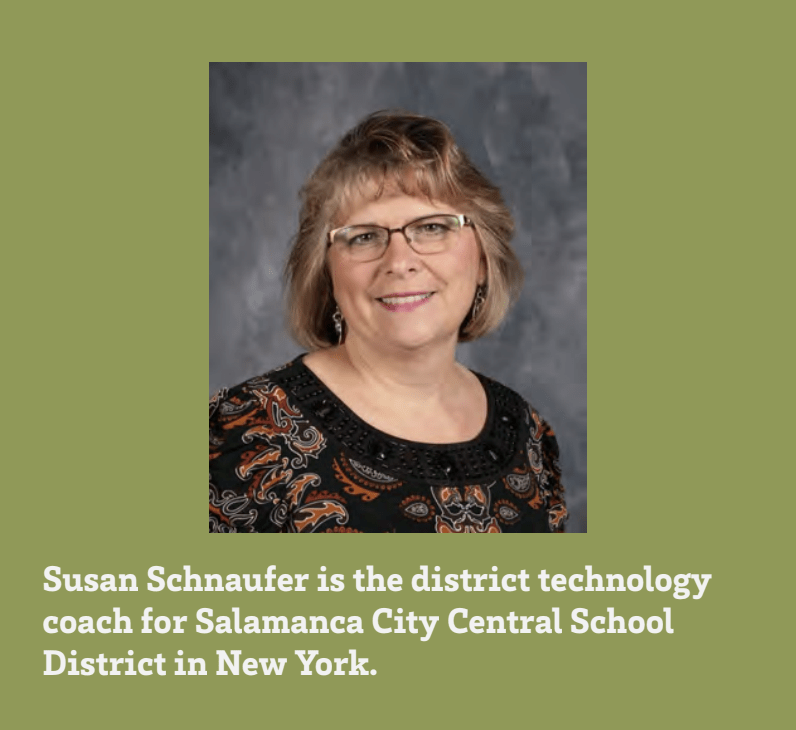By Susan Schnaufer, originally published in the May/June, 2022 issue of Equity & Access
A mother looks after and worries about her children. It does not matter where they are or how old they are; she worries and does her best to meet their needs. For the past several years, I have had the honor of being a mother for 1,400 students and 338 staff members when it comes to technology use for our district. My journey began in the fall of 2017 when I started a new position as a Technology Instructional Coach in the Salamanca City Central School District in rural Cattaraugus County, NY.
Pre-pandemic, we were rolling along acquiring a learning management system, working with teachers and students, providing substantial levels of professional development to use technology in the classroom, and organizing web resources for easy access. The support I was able to provide as an Instructional Coach was rewarding and beneficial. When the unthinkable happened, COVID-19, school was shut down “to flatten the curve.”
During the initial and many subsequent shutdowns over the next 26 months, my task for the school district was to make sure that all our students had equal access to the technology they needed to learn remotely. My mission was to help close the digital divide and make internet access both widely available and reasonably affordable for students, families, and staff.
While this may sound like a simple goal, it soon became clear that achieving this was very complicated. In fact, nearly two years after the pandemic started, we still haven’t completely met this goal. But by following a thorough, multifaceted plan, we have made real progress. I think the work in our district can inform other educators facing the same problems.
Our rural, indigenous district is located about 60 miles south of Buffalo, N.Y., and is located within the Allegany Indian reservation, which is governed by the Seneca Nation.
We serve 1400 students district-wide, both Native American and non-native students. The region experiences high poverty and our remote geography makes broadband access and cell service a substantial impediment.
When our schools closed in spring 2020, the district needed to secure a 1:1 technology platform for all students and staff. This presented a supply chain challenge. We moved heaven and earth to meet this demand to provide enough computers for each learner and employee. Every individual was at a varying level of digital proficiency and some teachers truly struggled with getting students to use devices. It was a struggle just to keep each device charged, not to mention updated with the latest versions of software.
Our instructional staff were frustrated
Before the virus, students weren’t always consistent about having their devices available during instructional time, as a result, they weren’t being used as an everyday learning tool. Coincidentally, a week after the first shut down occurred, we had a pre-planned staff development day on digital instruction. Unfortunately, all schools closed before that training occurred, and many teachers didn’t have the supplies they needed to teach at home.
The district quickly responded, getting teachers the technology and other supplies they needed to be fully remote until the end of the year. We deployed technology assets through our transportation department, pupil services & technology departments. It was an incredible organizational lift.
In a rural community connectivity is often spotty for some families and non-existent for others. Some had strong broadband, while others use satellite internet or cell service. Those who had access to broadband couldn’t afford the added monthly charges and still others lived in areas with almost zero option for service.
The district deployed Wi-Fi-equipped school buses those low coverage areas so that students could come to those locations to pick up and drop off worksheets packets or to use the internet for online learning.
During summer 2020, the school break allowed us to accelerate technology training. Pre-K to sixth grade teachers needed to learn the district’s learning management system. We conducted multiple group and in-person trainings over Zoom.
We implemented a hybrid instructional model in ace-ed.org 11 fall 2020. Many of our students live in multigenerational households and some of the families in our district were dealing with significant health issues. There were many families that were hesitant at that time to return to in-person learning. We provided a fully remote and hybrid option to all families.
Our district bought hotspots and loaned them to families. This allowed us to more effectively bridge bandwidth gaps in outlying areas of our small city. But still, problems plagued us. Some families didn’t have sufficient wifi to even use a hotspot while YouTube was blocked on several devices. This was a major impediment because many of our teachers assign students to watch videos and other teachers make YouTube videos for their students. We worked to overcome this by using Microsoft Stream to share instructional videos teachers were creating for their students.
When we came back to school in the fall of 2020, we created a command center in one of our largest classrooms.

Our technology director, technicians, instructional coaches, administrators, and I all pitched in to troubleshoot and provide technical assistance to students, families and teachers. Our new hotline answered questions for days from 7:00 a.m. until early evening.
It was evident we needed more IT support. We hired three additional technicians to help students and their families navigate the technical complexities of hybrid programming. A help desk ticket system was launched to prioritize requests and better manage the help we offered to staff and students and their families.
As Covid mutated, we have had to resume, pause, and re-launch our programs multiple times.
But because all our teachers have district laptops and Zoom accounts and most have document cameras, as well as a learning management system, we have been able to provide consistent programming and support.
One thing I’ve noticed is that sometimes we overestimate students’ ability to use all aspects of technology. We assume that because kids are digital natives, they know how to properly search online, create documents, and understand how to use email. This is not always the case and students really need to be taught how to use technology properly and effectively for school purposes.
This discovery led our district to add a computer teacher for grades 4 through 7 for the upcoming school year. Now students who start to learn basic computer skills, such as keyboarding, in their early grades, can continue to progress before they reach high school.

In addition to computer skills, we also turned to education technology. We’re lucky that a high school teacher who introduced Turnitin to her students is now the school’s librarian. She’s been able to show all upperclassmen how to use the tool to not only check for plagiarism but also to improve their writing. And because the tool is web-based, students can find and complete their work whether they are in school or learning at home.
My biggest desire is still to close the digital divide in our community because poverty impacts technology access. Thanks to several changes since the pandemic first shuttered schools nearly two years ago, our district has been able to begin to bridge the chasm that many of our students felt every day. Internet access is equity. As the access improves, we will continue to strive to close the gap further.
The American Consortium for Equity in Education, publisher of the "Equity & Access" journal, celebrates and connects the educators, associations, community partners and industry leaders who are working to solve problems and create a more equitable environment for historically underserved pre K-12 students throughout the United States.
- American Consortium for Equity in Educationhttps://ace-ed.org/author/admin/
- American Consortium for Equity in Educationhttps://ace-ed.org/author/admin/April 23, 2025
- American Consortium for Equity in Educationhttps://ace-ed.org/author/admin/
- American Consortium for Equity in Educationhttps://ace-ed.org/author/admin/







